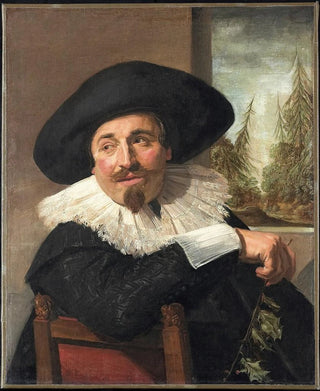Portrait Painting of Isaac Abrahamsz Massa - Frans Hals | Art print


View from behind

Frame (optional)
In the fascinating world of 17th-century painting, few artists manage to capture the human essence with as much vibrancy as Frans Hals. His iconic work, the Art print of Isaac Abrahamsz Massa, stands out for its ability to transcend mere portraiture and offer a true immersion into the soul of the subject. This painting, depicting a businessman of the era, not only demonstrates Hals's technical mastery but also his unique talent for conveying the personality of his subjects. As viewers contemplate this piece, they are transported into a universe where every detail matters, where each brushstroke tells a story.
Style and uniqueness of the work
Frans Hals's style is immediately recognizable, characterized by a dynamic approach and bold use of light and shadow. In the Art print of Isaac Abrahamsz Massa, Hals manages to create a lively and almost tangible atmosphere. Massa's face, with its expression that is both serious and engaging, seems to emerge from the canvas as if he is about to speak. The texture of the clothing, rendered with remarkable finesse, testifies to the artist's skill in playing with materials and bringing the canvas to life. The color palette, subtly nuanced, enhances the sense of depth and realism, inviting viewers to linger on every detail. This portrait does not merely depict a man; it captures an era, a culture, and a way of life.
The artist and his influence
Frans Hals, born in 1582 in Antwerp, is one of the pioneers of modern portraiture. His innovative approach influenced many artists, both during his lifetime and beyond. By focusing on the individuality of his subjects, Hals paved the way for a new way of conceiving the portrait, where emotion and personal expression took precedence over the rigid conventions of the past. His technique of painting en plein air, often executed outdoors, allowed him to capture natural light and give his works an unparalleled vitality. The Art print of Isaac Abrahamsz Massa is a perfect example of this approach, illustrating the

Matte finish

View from behind

Frame (optional)
In the fascinating world of 17th-century painting, few artists manage to capture the human essence with as much vibrancy as Frans Hals. His iconic work, the Art print of Isaac Abrahamsz Massa, stands out for its ability to transcend mere portraiture and offer a true immersion into the soul of the subject. This painting, depicting a businessman of the era, not only demonstrates Hals's technical mastery but also his unique talent for conveying the personality of his subjects. As viewers contemplate this piece, they are transported into a universe where every detail matters, where each brushstroke tells a story.
Style and uniqueness of the work
Frans Hals's style is immediately recognizable, characterized by a dynamic approach and bold use of light and shadow. In the Art print of Isaac Abrahamsz Massa, Hals manages to create a lively and almost tangible atmosphere. Massa's face, with its expression that is both serious and engaging, seems to emerge from the canvas as if he is about to speak. The texture of the clothing, rendered with remarkable finesse, testifies to the artist's skill in playing with materials and bringing the canvas to life. The color palette, subtly nuanced, enhances the sense of depth and realism, inviting viewers to linger on every detail. This portrait does not merely depict a man; it captures an era, a culture, and a way of life.
The artist and his influence
Frans Hals, born in 1582 in Antwerp, is one of the pioneers of modern portraiture. His innovative approach influenced many artists, both during his lifetime and beyond. By focusing on the individuality of his subjects, Hals paved the way for a new way of conceiving the portrait, where emotion and personal expression took precedence over the rigid conventions of the past. His technique of painting en plein air, often executed outdoors, allowed him to capture natural light and give his works an unparalleled vitality. The Art print of Isaac Abrahamsz Massa is a perfect example of this approach, illustrating the
12,34 €






